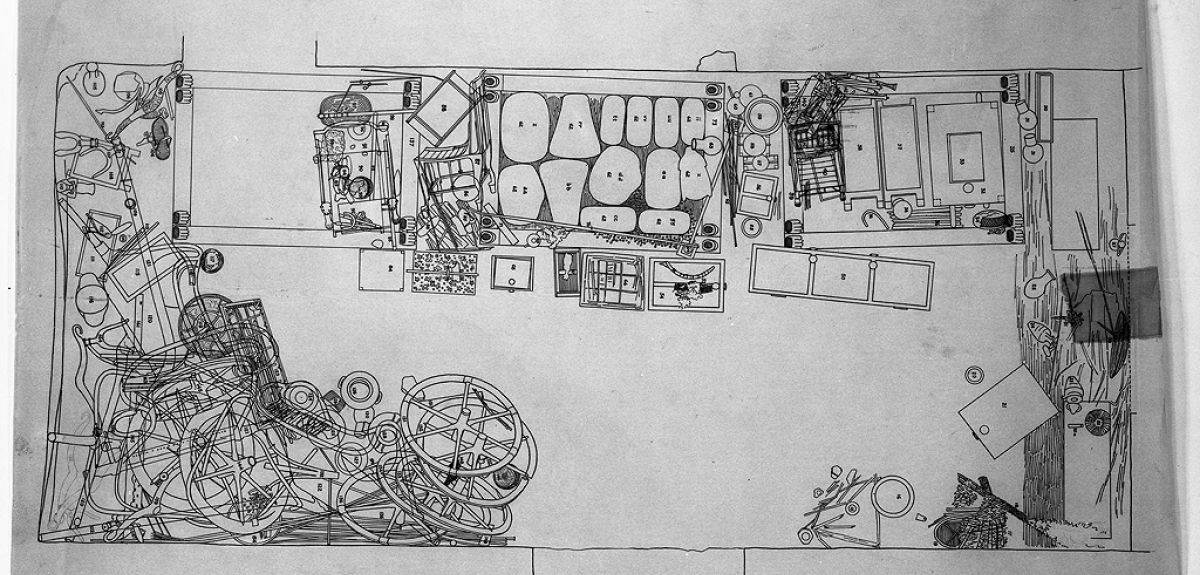
Drawings and journals from the discovery of Tutankhamun on show for the first time
Documents from Oxford University's Griffith Institute which shed light on the discovery of Tutankhamun’s tomb have gone on display to the public, many for the first time in their history.
The items, including paintings, journals, maps and photographs, are part of the Ashmolean Museum's summer exhibition, Discovering Tutankhamun, which opens today (24 July). Alongside ancient artwork and artefacts, they reveal the story of one of the most significant archaeological discoveries of the 20th century, and the storm of public enthusiasm which it sparked in the 1920s.
The Griffith Institute, which celebrates its 75th anniversary this year, houses more than 3000 of Howard Carter’s original record cards, amongst over 15,000 items in its Tutankhamun Archive. Carter, the archaeologist who discovered the pharaoh's tomb in 1922, used these cards to record every artefact in meticulous detail. His hand-written descriptions and pencil drawings provide a thorough record of the excavation as well as the treasures he uncovered.
'We estimate that only 20-30% of the items from the tomb have been examined scientifically. There's still a huge amount to be discovered,' said Cat Warsi, Archive Assistant at the Griffith Institute. 'We have photographs of an ornate chair from the tomb which shows Tutankhamun's original name, Tutankhaten, has been replaced.
'This could show his rejection of his father's religious movement, which acknowledged the sun-disc – the aten – as a supreme being. Beyond that, we can look at the materials from which these objects are created and find out about the extent of ancient Egyptian trade links. A single artefact can tell you a huge amount about the politics of the time.'
Accompanying the cards are the photographs taken by Harry Burton, which document the artefacts themselves as well as their position in the tomb and in relation to one another.
'We know very precisely where everything was found in the tomb,' said Vincent Razanajao, Keeper of the Archive. 'Since 1995, most of that information has been digitised, and in the future we hope to interlink the data to reflect the relationships between objects as they were found. We’d be able to rebuild the tomb in the virtual world. We're used to studying objects individually, or according to type – for instance, shrines, statues, sarcophagi – but there’s still more to find out about how these objects relate to one other.'
Carter was a trained artist, who travelled to Egypt as a teenager to assist in drawing copies of the decorated tombs, and many of his watercolours are collected in the Griffith Archive. Studies of modern Egyptian wildlife sit alongside versions of the same animals in tomb paintings: waterfowl, dogs and birds-of-prey are all represented in such detail that in most cases the exact species can be identified.
Also on display at the Ashmolean exhibition are Carter’s diaries, including a pocket journal in which he recorded the day-to-day activity of the excavation. The Griffith Archive of correspondence reveals the community of archaeologists and other experts who worked on the tomb.
'Only one team was allowed to work at the site in the Valley of Kings at a time, and the team which preceded Carter's group claimed that there was nothing else to be found. There’s even a popular story, though it may or may not be true, that Lord Carnarvon was about to withdraw funding only a few months before the tomb was found, and Howard Carter offered to fund another season of excavation out of his own pocket.
'The clearing of the tomb took ten years, and it seems many people didn’t last that long - Carter doesn’t seem to have been an easy man to work with! He was quite pernickety. It’s easy to overlook the personalities of the individual archaeologists, almost a century later, but from his correspondence we gain a living impression of Carter,’ said Warsi.
'In the exhibition you’ll be able to see the page of his diary in which he records finding a tomb "with seals intact": that is, it had never been opened before.'
Professor Christopher Brown CBE, Director of the Ashmolean, said: 'Discovering Tutankhamun tells a thrilling story of archaeological discovery and explores its impact on both scholarship and popular culture.
'The exhibition shows archival material which has never been seen in public before, with major loans from around the world, and provides the opportunity to re-examine pivotal moments in both ancient and modern history.'
Discovering Tutankhamun opens on 24th July and runs until 2nd November. Advance booking is recommended.
 New study estimates NHS England spends 3% of its primary and secondary care budget on the health impacts of temperature
New study estimates NHS England spends 3% of its primary and secondary care budget on the health impacts of temperature
 International collaboration launches largest-ever therapeutics trial for patients hospitalised with dengue
International collaboration launches largest-ever therapeutics trial for patients hospitalised with dengue
 Oxford-built multi-agent assistant for cancer care to be piloted in collaboration with Microsoft
Oxford-built multi-agent assistant for cancer care to be piloted in collaboration with Microsoft
 World's first Phase II Nipah virus vaccine trial launch
World's first Phase II Nipah virus vaccine trial launch